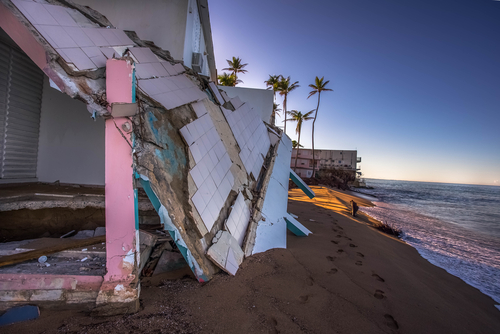
After the Category 1 Hurricane Fiona slammed Puerto Rico, the devastation led to President Joe Biden declaring a disaster across the island this week, followed shortly by a Public Health Emergency from Health and Human Services Secretary Xavier Becerra due to flooding.
Even as Federal Emergency Management Agency (FEMA) teams fanned out across the Caribbean island and the agency rushed disaster relief efforts there, hundreds of thousands of residents remained without power or running water. As of Sept. 21, Puerto Rico’s emergency portal system confirmed that 1 million homes and businesses remained without power and more than 450,000 lacked proper water service.
In the storm’s wake rode haunting reminders of the Category 5 Hurricane Maria of 2017, which killed thousands in Puerto Rico and wrought catastrophic damage to its infrastructure, including months-long blackouts.
“We will do all we can to assist officials in Puerto Rico with responding to the impact of Hurricane Fiona,” Becerra said of the latest crisis. “We are working closely with territory health authorities and our federal partners and stand ready to provide additional public health and medical support.”
The Department of Health and Human Services (HHS) has deployed a 15-person health and medical task force, as well as a 10-person incident management team, to the island to help determine what federal public health and medical resources could help Puerto Rico recover. At the same time, five incident management assistance teams from FEMA, along with four urban search and rescue teams, mobile emergency response support, incident support base, and staging management teams, are working to aid response efforts.
According to a briefing from Homeland Security Secretary Alejandro Mayorkas, FEMA had prepositioned supplies on Puerto Rico with more than 7 million liters of water, 4 million meals, 215 generators, and other emergency supplies in preparation for disaster. Distribution of such commodities are among the tasks more than 450 members of the Puerto Rico National Guard have undertaken, on top of search and rescue, security operations, and more, with support from U.S. Customs and Border Protection.
Complicating matters in that assessment were that days of continuous rainfall from the hurricane have increased the risks of mud, rock, and landslides throughout the island. Now, Puerto Rico is in the grips of an excessive heat advisory for several days, leading emergency personnel to advise residents to stay alert for hazards.
A major component of the response is focused on getting power restored quickly to avoid a repeat of 2017. According to Luma, the Puerto Rican power company, as of 4:30 a.m. on Wednesday, Sept. 21, power had been restored to 376,000 customers, but extensive damage assessment and re-energization efforts remain underway.
“All across Puerto Rico, damage assessment, reenergization, and restoration efforts continue as LUMA, in coordination with PREPA, works around the clock to overcome the damages of Hurricane Fiona,” Abner Gómez, LUMA Public Safety Manager, said. “We are continuing critical initial aerial inspections of the island’s transmission system, clearing debris, processing repairs, and restoring power to customers as quickly and safely as possible. While some areas of Puerto Rico have suffered extensive damage, our LUMA teams are determined to make progress and will not stop until every customer in Puerto Rico is restored.”
Those efforts are being pushed in coordination with the governor’s office, the Puerto Rico Electric Power Authority, U.S. Department of Energy, U.S. Army Corps of Engineers, and FEMA teams.




